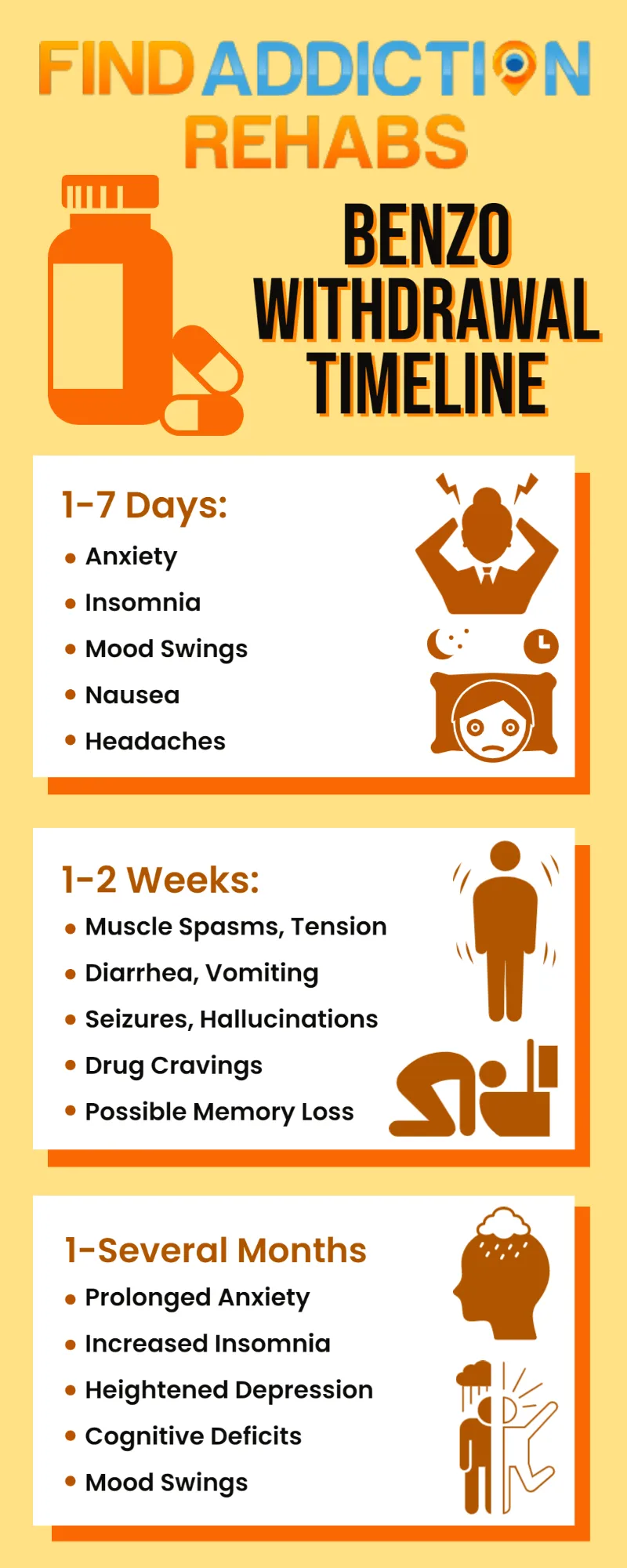Benzo Withdrawal – How Long Does It Last?
Table of Contents
Benzo Withdrawal: According to the Drug Enforcement Administration (DEA), benzodiazepines are considered Scheduled IV controlled substances. Schedule IV substances are drugs with a lower potential for abuse and dependence in relation to other highly addictive drugs.
However, this does not mean it’s impossible to become dependent on Schedule IV drugs. In fact, many individuals who use benzodiazepines can easily become addicted to the soothing and calming effect it has on the body and central nervous system.
The longer this drug is consumed, the more difficult it is to wean off them. Unfortunately, since benzos are classified as a Schedule IV drug, it’s commonly misconceived as a drug that’s safe to use infrequently, or in small quantities.
Benzodiazepines are a class of sedatives and tranquilizers that are prescribed to treat a variety of conditions including anxiety, insomnia, muscle tension, and more.
Well-known examples of benzodiazepines include Xanax, Klonopin, Restoril, Ativan, and Valium. Although they are intended to treat specific disorders, benzos are notoriously over-prescribed and widely available. In fact, Xanax is the single most prescribed psychiatric medication throughout the United States.

Unfortunately, as one of the most prescribed medications, it also is one of the most commonly abused drugs. Individuals who use and abuse benzos tend to build a high tolerance of the drug over time — requiring them to increase their dosage just to feel its intended effects. As this drug is taken more and more, it becomes increasingly difficult to detox. Due to this, the withdrawal timeline for benzodiazepines is seemingly precarious — there’s no definite timeline because of the varying nature of the drug type and intensity of the addiction. Unfortunately, everyone reacts differently to benzo withdrawal — many even experience the symptoms for years after their initial detox.
Additionally, benzodiazepine withdrawal symptoms will worsen if the individual decides to quit cold turkey and is unsupervised by medical professionals. These withdrawal symptoms are dangerous but can be manageable with the right team of professionals.
Why Does Withdrawal from Benzodiazepines Cause Symptoms?
Benzodiazepines also called “Benzos,” are a class of depressants that have a euphoric, calming effect on the nervous system. These prescription tranquilizers have addiction-forming chemical properties that make them highly addictive to those who ignore the recommended dosage and are used in large quantities. There are currently two different forms of benzodiazepines — hypnotics and anxiolytics. Hypnotics are shorter acting and primarily used for treating sleep problems. Anxiolytics, on the other hand, are longer lasting and used to subdue anxiety.
The produced calming effect that benzodiazepines provide is essential for those who have trouble sleeping or struggling with heightened anxiety; however, it involves lowering one’s blood pressure and heart rate, which, over time, can be dangerous. With prolonged use, the body grows dependent on these functions being chemically reduced. As a result, one’s GABA receptors suffer greatly. The gamma-aminobutyric acid (GABA) is an amino acid that acts as the primary neurotransmitter for the central nervous system.
A person’s GABA is responsible for sending chemical messages through the brain to the nervous system while reducing the activity of nerve cells. This inhibitor plays a significant role in one’s behavior, cognition, and response to stress. When damaged or reduced, the brain suffers greatly and can develop a variety of disorders like anxiety, depression, schizophrenia, and insomnia. The overuse of benzos increases these risks.

However, if the medication is taken away or the individual quits cold turkey, the results can be deadly. Blood pressure and heart rate will skyrocket, and the body will be unable to regulate itself on its own. Additionally, high blood pressure will bring about a variety of symptoms in addition to the symptoms that arise from sudden withdrawal. In the most extreme cases, seizures can occur, leading to coma or, worse, death.
Proper methods of withdrawal are critical when it comes to benzodiazepines. The body’s natural chemicals need to get used to the absence of the benzos, as it relearns to regulate its natural functions. This process is not only physically taxing, but it’s emotionally strenuous as well. That’s why it’s incredibly important to know and understand the process and associated risks that are involved with benzo withdrawal.
Getting sober from these highly addictive drugs is essential, but it must be done correctly and with the help of your primary physician or a reputable addiction treatment facility that offers quality detox services.
Understanding Benzodiazepine Withdrawal Symptoms and its Timeline
It’s important to note that there is not one specific timeline that dictates exactly how long withdrawal from benzodiazepines will last, as each individual experiences withdrawal differently. However, there are a few factors that can influence the duration — and the intensity — of benzodiazepine withdrawal. Those include:
- The length of time the benzos were being taken for
- The current dosage
- Why the medication was needed (existing medical conditions)
- The presence of mental health issues or family history of it
- Any predisposition to addiction or drug abuse (family history of addiction)
- Stress levels
- Emotional stability
- Access to quality medical and psychiatric attention
Additionally, the onset of benzodiazepine withdrawal can also depend on the type of sedative/tranquilizer that’s being used and abused. For example, withdrawal from short-acting benzos like alprazolam (Xanax), temazepam (Restoril), and lorazepam (Ativan) tend to leave the system quicker, enabling withdrawal symptoms to start in approximately eight to 12 hours.

For those who were taking long-acting benzos like clonazepam (Klonopin), diazepam (Valium), and flurazepam (Dalmane), withdrawal varies, as they are known to stay in the system for much longer. In most cases, it can take one to two days for symptoms to begin presenting themselves. However, there have been circumstances where it has taken up to a week for withdrawal to begin. Since these types of benzodiazepines are long-acting agents, their withdrawal time will also last longer.
On average, physical symptoms usually present themselves first in benzodiazepine withdrawal. These symptoms include:
- Headaches
- Nausea and vomiting
- Aches and muscle tension localized in the jaw, back, and other areas of the body
- Loss of muscle control (spasms, tremors, and numbness)
- Seizures
- Insomnia and restlessness
- Blurred vision and sensitivity to light
- Changes in sense of smell and appetite
- Fever and sweating
- Weight loss
Additionally, psychological symptoms of benzo withdrawal include:
- Anxiety and panic attacks
- Depression
- Suicidal ideations
- Obsessive-compulsive disorder
- Feelings of unreality and dysphoria
- Poor cognitive functions and memory loss
- Confusion and paranoia
- Mood swings
- Nightmares
Although benzodiazepines are prescription drugs designed to treat specific medical conditions, they are still highly addictive. Unfortunately, individuals don’t need to abuse the drugs for long periods of time in order to experience withdrawal. Withdrawal symptoms can occur after as little as one month of use. However, 40% of those who use benzos for longer than six months experience moderate to severe symptoms after quitting suddenly.
Importantly, once the beginning stages of withdrawal commence, it’s critical to be in a safe environment that’s designed for detoxing. Benzodiazepine withdrawal can be quite severe since its affects individuals on both a physical and psychological level. Not to mention, individuals have a high risk of suffering from grand mal seizures — especially if they quit cold turkey. Hallucinations and delirium can also occur during withdrawal.
Benzodiazepines are not safe to quit on one’s own. Whether it’s at a hospital or an inpatient treatment center, individuals detoxing from benzos should be attended to by medical professionals to ensure safety and stabilization during this strenuous process. This is especially important for individuals who also present with a mental health disorder — also known as co-occurring disorders. Specialized treatment that focuses on dual diagnosis is critical during this time.
Finally, it’s important to consider the rebound effect. The rebound effect describes the emergence of symptoms that were being controlled by medication but reappeared after that same medication is discontinued. Specifically, benzos are prescribed to address symptoms of anxiety disorders and insomnia. When they begin the detox phase, many of these same symptoms will increase and intensify. Distinguishing between the rebound effect and withdrawal-specific symptoms is critical.
Below, we outlined a general timeline of benzo withdrawal to provide additional clarity.
The First Few Days (1- 7 Days)
On average, withdrawal symptoms start to appear with a couple of days; however, in the most severe cases, symptoms can start within a few hours after stopping the medication. This is referred to as the early withdrawal phase. During this stage in the withdrawal process, individuals may experience anxiety and insomnia — conditions that the benzos were originally designed to treat in the first place. Other milder symptoms like mood swings, nausea, and headaches will start to take effect as well.
Seven to Fourteen Days
Unfortunately, the phrase “it gets worse before it gets better” applies all too well to the withdrawal period of benzodiazepines — symptoms only get worse as it progresses through its different phases. In fact, during the seven to 14-day mark, symptoms begin to peak, and the acute withdrawal phase begins. Individuals will notice that their milder symptoms will begin to intensify, and new ones will begin to appear.
These include muscle spasms, tension, diarrhea, vomiting, blurred vision, seizures, hallucinations, decreased appetite, drug cravings, short-term memory loss, and more. Since the symptoms can be so severe, many medical professionals prefer to administer medications that will treat and alleviate some of the most intense symptoms.
Additionally, professional monitoring during this stage of withdrawal is critical, as suicidal thoughts and actions may begin to occur. As said earlier, the true timeline of withdrawal is never exact, as many people react differently when they discontinue the use of benzos. However, there are cases that show the acute withdrawal stage can last anywhere from two weeks to several months.
One to Several Months
While still in the acute withdrawal stage, symptoms are still present but fade and fluctuate. However, many of the psychological effects of this addiction will continue to persist, especially anxiety. Some believe the worst of it is over, but it’s hard to be specific about when that will occur since withdrawal varies. Even if they are feeling better, it’s important to keep in mind that setbacks may occur as the symptoms continue to ebb and flow.
Additionally, it’s not uncommon for patients with more severe benzodiazepine addictions to still be experiencing intense symptoms at this time. As mentioned earlier, many long-acting benzodiazepines are notorious for prolonging the withdrawal timeline since they tend to stay in the body for much longer periods of time.

The final stage of benzo withdrawal is actually one of the rarer phases. In fact, studies show that 10 to 25 percent of chronic benzodiazepine users experience protracted withdrawal. This stage of detox is precarious as it can come and go for several months. Luckily, protracted withdrawal doesn’t typically last longer than a year.
During this stage, detoxing individuals may experience tingling in their arms and legs, prolonged anxiety, cognitive deficits, increased insomnia, heightened depression, and mood swings that are difficult to manage. Symptoms in the protracted stage tend to be severe and manifest at random.
Benzo Withdrawal Timeline: Find Addiction Rehabs is Here to Help You
Although benzodiazepines are designed to treat specific medical conditions, they are a brand of drugs that are very easy to get addicted to and very hard to detox from. Long-term abuse of benzos causes the brain and the body to become dependent on them, and the results can be deadly when treatment is neglected. If you or someone you love is abusing benzos, it’s time to get them help before their addiction gets worse.
At Find Addiction Rehabs, we are here to assist you during this difficult time. With a nationwide database of treatment centers and detox facilities, our team can pair you with the perfect center that focuses on benzodiazepine detox and treatment.
Every facility we work with provides the full continuum of care for addiction and offers dual diagnosis treatment for those who are battling both addiction and one or more mental health disorders. The road to recovery is right within reach; let our team help you take those important first steps. For more information about our services and addiction treatment resources, please give us a call today.
Deborah Tayloe is a freelance writer specializing in health and sciences. Deborah earned a B.S.Ed. in Secondary Education/English, accompanied by a Spanish minor. Her writing expertise allows her to craft engaging, impactful articles to help people be well.
In addition, she holds a fully accredited Certificate of Natural Medicine and is a certified Herbalist. Through her understanding of complementary medicine, Deborah helps medical professionals give people the information they need to embrace natural approaches to wellness.
When she’s not working, Deborah trains for 5K races and advocates for animal rights.


